Arizona Articulation Proficiency Scale (ARIZONA-4)
Complete Kit
- Ages 18 months to 21 years
- Testing Time 5 - 20 minutes
- Administration Individual
- Copyright 2017
-
Product Code W-688 ( MR #066661 )
* Qualifications required to purchase this item. Click here to complete the qualifications form.
* Regional restriction: This item is only available for sale within Canada.
Price $514.80
Contents
-
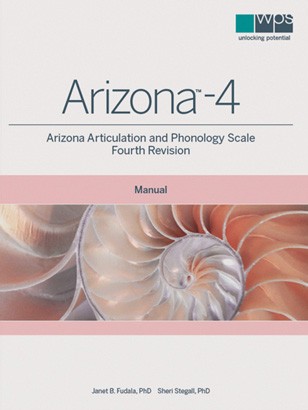
Arizona Articulation Proficiency Scale (ARIZONA-4)
ARIZONA-4 Manual
Fourth Revision
$192.00 -
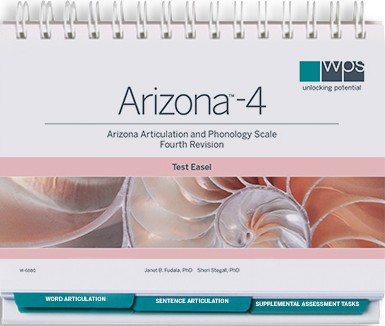
Arizona Articulation Proficiency Scale (ARIZONA-4)
ARIZONA-4 Test Easel
Fourth Revision
$264.00 -
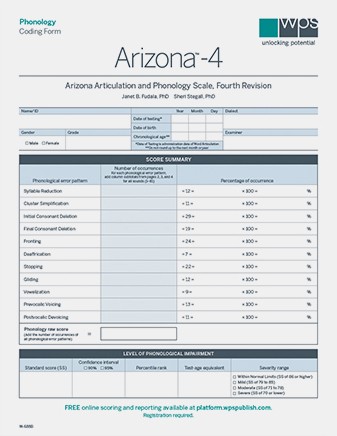
Arizona Articulation Proficiency Scale (ARIZONA-4)
ARIZONA-4 Phonology Coding Form (25)
Fourth Revision
$80.40 -
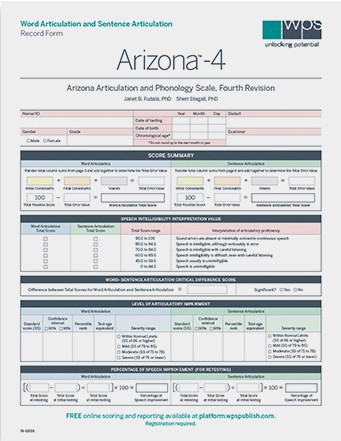
Arizona Articulation Proficiency Scale (ARIZONA-4)
ARIZONA-4 Word and Sentence Articulation Record Form (25)
Fourth Revision
$80.40
- Three tests in one assessment: Word Articulation, Sentence Articulation, and Phonology
- All-new normative data
- Extension of the standardized age range to 21 years, 11 months, with guidance for describing and understanding the speech of adults of all ages
- Modified scoring system for more effective identification of individuals with speech sound disorders
- Five optional tasks that inform treatment plan development
- Scoring guidance for dialectal variations
- Full-color illustrations that are more engaging for young children
- Digital stimulus images
- FREE online scoring and report generation through the WPS Online Evaluation System
- Understanding and describing an individual’s level of articulatory ability and overall speech intelligibility in both single-word and connected speech
- Comparing single-word and connected-speech articulatory abilities
- Determining the extent to which phonological impairment may contribute to an individual’s articulatory deficits, and describing the specific types of phonological error patterns that are displayed
- Facilitating early identification of speech-sound development concerns and determining whether an individual may benefit from treatment services
- Identifying and prioritizing speech targets for individualized intervention through analysis of the examinee’s specific articulatory/phonological deficits and relative strengths, including the production of consonants, consonant blends, vowels, and vocalic /r/
- Monitoring improvement in an individual’s speech sound production over time
- Evaluating the degree of consistency in an individual’s production of misarticulated sounds, the impact of speech sound deficits in continuous language and everyday speech, and the need for further language assessment or intervention
- Total Scores and associated Speech Intelligibility Interpretation Values
- Standard Scores and associated Severity Ranges for level of articulatory and phonological impairment
- Word–Sentence Articulation Critical Difference Score
- Percentage of Occurrence for phonological error patterns
- Percentage of Speech Improvement score for retesting
-
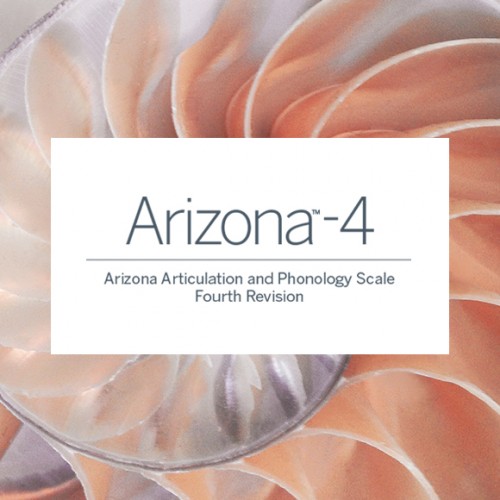
Arizona Articulation Proficiency Scale (ARIZONA-4)
ARIZONA-4 Digital Kit
$438.00 -

Arizona Articulation Proficiency Scale (ARIZONA-4)
ARIZONA-4 Print & Digital Combination Kit
$625.20 -

Arizona Articulation Proficiency Scale (ARIZONA-4)
ARIZONA-4 Manual
Fourth Revision
$192.00 -
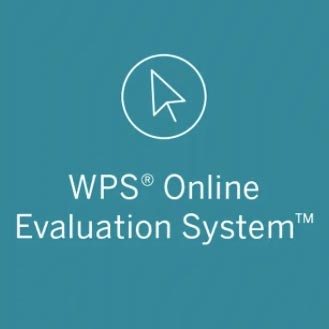
Arizona Articulation Proficiency Scale (ARIZONA-4)
ARIZONA-4 Online Manual
WPS Online Evaluation System
$163.20 -

Arizona Articulation Proficiency Scale (ARIZONA-4)
ARIZONA-4 Test Easel
Fourth Revision
$264.00 -

Arizona Articulation Proficiency Scale (ARIZONA-4)
ARIZONA-4 Phonology Coding Form (25)
Fourth Revision
$80.40 -

Arizona Articulation Proficiency Scale (ARIZONA-4)
ARIZONA-4 Word and Sentence Articulation Record Form (25)
Fourth Revision
$80.40 -

Arizona Articulation Proficiency Scale (ARIZONA-4)
ARIZONA-4 Digital Administration Guide
WPS Online Evaluation System
$44.40 -

Arizona Articulation Proficiency Scale (ARIZONA-4)
ARIZONA-4 Digital Stimulus Images
WPS Online Evaluation System
$189.60 -

Arizona Articulation Proficiency Scale (ARIZONA-4)
ARIZONA-4 Digital Stimulus Images with Administration Guide
$229.20
No additional information available for this item.

 Proud to be Canadian
Proud to be Canadian